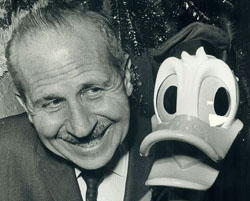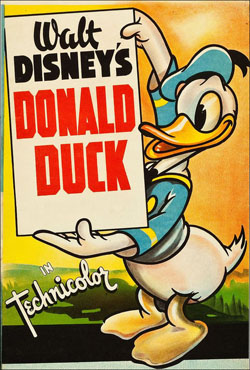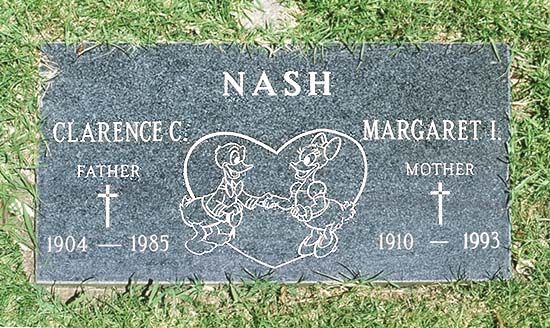
Suspended Animation #365
Clarence Nash was not immediately known to the public as the voice of Donald Duck. Walt Disney always felt that the voice was just one of many elements in a character and so actively tried not to publicize any particular vocal artist.
Walt felt that the lines the storyman wrote, the design of the character by the animator, and even how other animators made the character move and react were equally important in the final character. In addition, Walt was probably fearful that another studio might steal his voice talent if he publicized someone’s name.
 “It was all right with me that people didn’t know who I was but I was happy when they eventually did find out,” Nash stated. “In the early days, Walt didn’t want us voices to have any publicity. I went along with his wishes but one time my name got out in the newspapers. Walt and I had a big argument over it, but, when I left his office, I wasn’t upset. Walt was a very fair man. I ended up with a raise.
“It was all right with me that people didn’t know who I was but I was happy when they eventually did find out,” Nash stated. “In the early days, Walt didn’t want us voices to have any publicity. I went along with his wishes but one time my name got out in the newspapers. Walt and I had a big argument over it, but, when I left his office, I wasn’t upset. Walt was a very fair man. I ended up with a raise.
“Before Walt came up with the idea, I had never even thought of being angry or laughing in that voice. But the more I learned to use it, the more it developed. Walt believed it was important for Donald to have a strong personality so he would seem alive.”
Donald’s voice was known as a “stunt voice” because it was not created using the familiar voice placements or combinations that most voice actors use to create and repeat a voice.
However, this did not prevent Hanna-Barbera animation studios from trying to duplicate that ducky sound both in several of the Tom and Jerry theatrical cartoons with Little Quacker (voiced by “Red” Coffey, the stage name of Merle Coffman) and later on their Yogi Bear television series with “Yakky Doodle” (voiced originally by Jimmy Weldon, who was a local Los Angeles area children’s show host with a ventriloquist doll named Webster Webfoot who also spoke like Donald Duck).
These imitations often led to some confusion.
 In 1977 when I talked with him, Clarence Nash was not happy. “Everybody thinks Mel Blanc is Donald Duck! He’s not. I’m Donald Duck,” he said. “We’ve had some problems with people who say they’re the ‘original Donald Duck’ and we’ve even had some problems with them at the Disney Studios in the past. Every once in a while, we hear that I died and we get Christmas cards saying they’re sorry I passed away during the year.”
In 1977 when I talked with him, Clarence Nash was not happy. “Everybody thinks Mel Blanc is Donald Duck! He’s not. I’m Donald Duck,” he said. “We’ve had some problems with people who say they’re the ‘original Donald Duck’ and we’ve even had some problems with them at the Disney Studios in the past. Every once in a while, we hear that I died and we get Christmas cards saying they’re sorry I passed away during the year.”
Donald cartoons are shown in dozens of countries and are usually dubbed rather than use subtitles. In the beginning, for foreign releases, Donald’s voice was dubbed by Nash into a foreign language. The words were written out phonetically for him but generally, Donald had very little spoken dialog.
“I had to learn to quack in Spanish, Portuguese, French, Italian, German, Dutch, Swedish and even Chinese,” stated Nash. “There were, however, foreign language coaches who helped me. I listened through earphones to the English dialogue, and I’d match the length and mood of the dialogue in that other language. It was critical to get everything down pat so they never had to re-animate. It had to seem like the language came out smoothly and matched the mouth movements of Donald.”
 When I interviewed Donald Duck director Jack Hannah in 1979, he said:
When I interviewed Donald Duck director Jack Hannah in 1979, he said:
“Clarence was always nice to work with. He did many little side voices, such as meowing cats or miscellaneous characters. One problem we always had was the understanding of Duck lines. He was great when he lost his temper and all of that.
“However we had to pantomime pretty well in the drawing what the Duck was thinking or doing because if you tried to get over a gag or a line of dialog with understanding, you were in trouble using that voice. One thing I’ll say about Clarence Nash: he was a hard worker and I actually thought a couple of times he was going to faint on me. The blood would come to his face on these wild tantrums especially where they were prolonged.
“It was the bane of my existence to get that voice understood! It was aggravating as hell to do a picture with dialogue and not be able to understand the main character. But he did have a variety of moods and you could get over with strong poses what he was trying to tell you.
“I got some old acetates of a television show I made and I notice that Jimmie Dodd says, ‘And now Donald we’re going to take you around the world.’ The Duck asks, ‘Around the world?’ Jimmie replies, ‘Yes, that’s right. Around the world.’ We did it that way to be damn sure you could understand what was being said. Once a human said it, then you could understand the way the Duck said it. We did that in some of the cartoons, as well. If you heard the line repeated by a straight voice, it made it easier to understand the Duck.
“We always did a minus dialogue track whenever we did a cartoon so they could do foreign voices and fill them in for foreign release. Jack Cutting was in charge of the foreign department and he made sure the foreign voices were done and I never had anything to do with any of that.
“Well, not long ago, I talked with Clarence Nash on the phone. I mentioned something like, ‘Well, on those foreign voices, that was one good thing. You didn’t have to redo the Duck in different languages.’ But Clarence was very proud of the fact that anybody could understand him doing the Duck and he replied, ‘Oh, yes, I do Spanish. Listen to this.’
“And he did it in Spanish over the phone and he did a couple of other languages and to me it still sounded like the same old English you couldn’t understand. But, Clarence, knowing what he was supposed to be saying, naturally thought everyone else could understand him.'”
As Walt Disney stated on the Donald’s Silver Anniversary episode (November 1960) of the weekly Disney television show, “But of all Donald’s accomplishments, we’re the most proud of his efforts in spreading good will throughout the world. You might say Donald speaks a universal language. That is to say, that no one can understand what he says in any language but the whole world laughs at him.”
Nash was actively involved in 1984 with the 50th birthday celebration for Donald Duck, touring the country, giving interviews and appearing at special events.
In order not to spoil the festivities, Nash did not let people know he was suffering from leukemia. In what turned out to be his final public appearance, he went back to his hometown of Watonga, Oklahoma, on December 7, 1984, where Governor George Nigh declared that day to be “Clarence Nash Day” throughout the state of Oklahoma. Watonga renamed a street “Clarence Nash Boulevard” in his honor.
Nash was unfortunately too ill to ride on the City of Glendale Tournament of Roses float on January 1, 1985, which was themed to Donald Duck. I worked on that float and since I lived in Glendale knew and had interviewed Nash. He died February 20, 1985 at the age of 80. Today, animator Tony Anselmo does Donald’s voice, as he has done since Nash’s passing.
Besides Donald, Nash often supplied bird calls and animal sounds for Disney characters from Uncle Remus’ bluebird in The Song of the South to the meows for little Figaro the kitten in a handful of short cartoons to the earliest voices for Huey, Dewey and Louie.
By the way, Nash’s tombstone in the San Fernando Mission Cemetery in Mission Hills, California, is shared with his wife (who died in 1993) and has a carving of Donald and Daisy Duck holding hands.



 Jim Korkis is an internationally respected animation historian who in recent years has devoted his attention to the many worlds of Disney. He was a columnist for a variety of animation magazines. With his former writing partner, John Cawley, he authored several animation related books including The Encyclopedia of Cartoon Superstars, How to Create Animation, Cartoon Confidential and Get Animated’s Animation Art Buyer’s Guide. He taught animation classes at the Disney Institute in Florida as well as instructing classes on acting and animation history for Disney Feature Animation: Florida.
Jim Korkis is an internationally respected animation historian who in recent years has devoted his attention to the many worlds of Disney. He was a columnist for a variety of animation magazines. With his former writing partner, John Cawley, he authored several animation related books including The Encyclopedia of Cartoon Superstars, How to Create Animation, Cartoon Confidential and Get Animated’s Animation Art Buyer’s Guide. He taught animation classes at the Disney Institute in Florida as well as instructing classes on acting and animation history for Disney Feature Animation: Florida.




















































Of course Walt Disney felt that voice actors, story men and animators were of equal importance, and hence equally deserving of total anonymity. At the time Clarence Nash was hired, the only name ever credited on any Disney film was Walt’s own.
There’s a duck with a fair semblance of Donald’s voice in the 1938 Betty Boop cartoon “Sally Swing”, uttering Joe Penner’s famous catchphrase “Wanna buy a duck?” before losing his temper. I wish I knew who did the voice; the angry duck that Jack Mercer voiced in “The Foxy Hunter” a year earlier sounds completely different.
One of a kind, Nash. Not just behind one of the most unique voices in history but also adept at forging a believable, engaging character out of it.
Hannah’s posture in these recollections, albeit understandable, also have me wish he wasn’t the lone director on most Donald pictures after 1947. It’s not hard to imagine talents like, say, Chuck Jones, exploiting Don’s vocals with sophisticated dialogue for humorous contrast, the way Barks had already delivered in several cartoons before moving to comics. The joke precisely being that the duck was actually the more cultured of the barnyard lot yet the least understandable of them all.
Yet Hannah took the situation at face value, deciding to lower Don’s screentime in favor of his co-stars and thus failing to capitalize on the Duck’s personality when his fame was at his highest. Basically approaching his voice like an obstacle when it could have been a strength. See: fellow Disney director Jack Kinney, that, faced with a voiceless Goofy, came up with some of the funniest pictures with the character.
Disney must not have had a lock on that voice or on Nash’s services–at least not outside of motion pictures. Nash was on George Burns and Gracie Allen’s radio show for a couple of seasons in the early ’40s, doing his Donald Duck voice, but as Gracie’s pet duck, Herman.
The unintelligibility of that voice limited Donald’s possibilities on radio, I guess. He guest stars in a cute episode of NBC’S STORY SHOP titled “Donald Duck’s Vacation Adventures,” and a lot of Donald’s dialogue is “doubled,” as referred to in the column, wiith the STORY SHOP host repeating what the duck has just said.
I may be wrong, but my recollection is that Disney allowed Nash to do the Burns & Allen Show as long as the duck only quacked, not spoke. This requirement was waived for a Christmas show in which Gracie dreamed she visited Santa Claus (voiced by Arthur Q. Bryan) and a talking Herman accompanied her.
Somewhere there’s a captionless old New Yorker cartoon of a moviegoer angrily hushing the person behind him while Donald Duck is on the screen.
Is is true there were issues with censors over what they thought the duck was saying in his rages?
If there were any issues in Walt’s day, he’d have been able to put them to rest easily enough. When I was growing up, it was widely believed that Donald’s incomprehensible diatribes contained occasional swear words (just as everyone assumed the lyrics to Louie Louie” were filthy), but before the advent of home video there was no way for the general public to verify this. However, in the ’90s Disney did change a couple of Donald’s lines in the VHS release of the 1937 cartoon “Clock Cleaners” — “Says who?” and “Snake in the grass!” — because the Rev. Donald Wildmon of the American Family Association misinterpreted them as obscenities.
I’m curious if Clarence Nash was the first Donald Duck. I have a recording of “Arthur Godfrey’s Talent Scouts” radio program. One of the contestants was Joe Morrison. An Irish Tenor who appeared in a W.C. Fields film (“Poppy” I believe) in 1937. He said he was returning to show business after having been out of it for several years. He claimed he was the original voice of Donald Duck. I wondered if there was any truth to his claim.
What a nice article! Many interesting facts you seldom hear, and haven’t changed much in The Duck’s present life. All spot on. I printed and sent this and the previous article to Clarence’s daughters Kay, and Peggy (Kay is 90!). Kay loved them. Here’s a fun fact, Jimmy Weldon is my neighbor! He’s 98! Margie Nash had Bill Justice create that headstone.
“Can anyone understand what this duck is saying?” — lampshaded by Daffy in WHO FRAMED ROGER RABBIT?
People STILL think that Mel Blanc was the voice of Donald. In Ron Howard’s recently published memoir, “The Boys,” he talks about working with Blanc and describes him as the voice of several characters, including Donald.
As for other people claiming to be the “original” voice, there have always been these cranks. Leonard Maltin’s book on the Our Gang series has a whole chapter devoted to people falsely claiming to have been Gang members. There were even several women who claimed to be John Tenniel’s model for Alice in Wonderland, despite Tenniel saying that he did not use a model. In his old age, Mark Twain was always hearing from reporters that someone he had never heard of, who had claimed to be the “real Tom Sawyer,” had died. Twain wondered if Shakespeare had to deal with people claiming to be the real Hamlet. Taking credit for someone else’s work is an easy way to get attention.